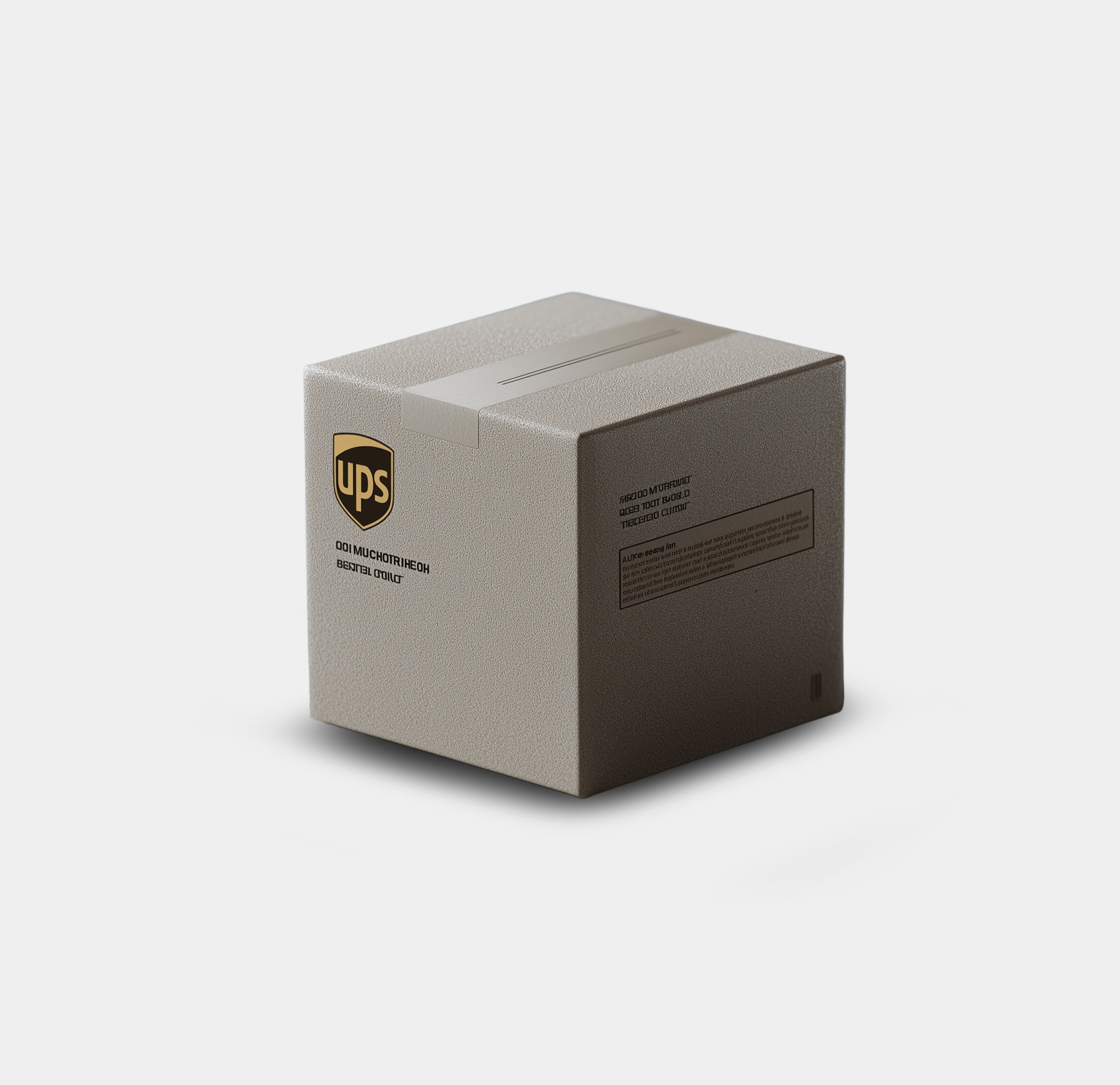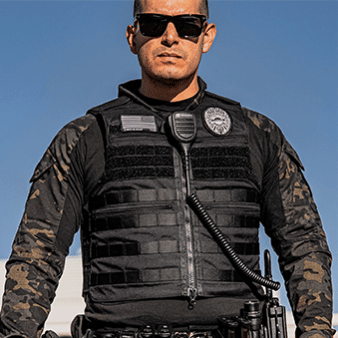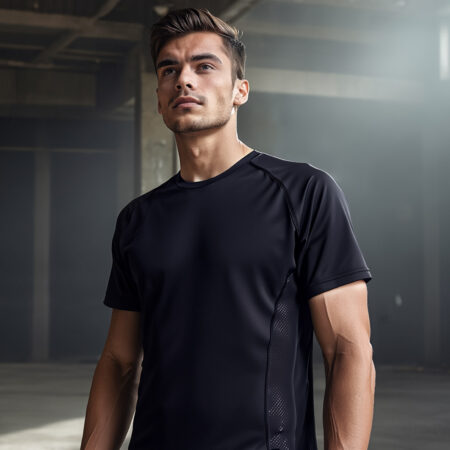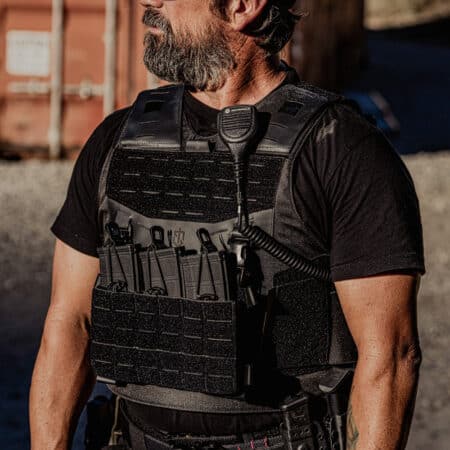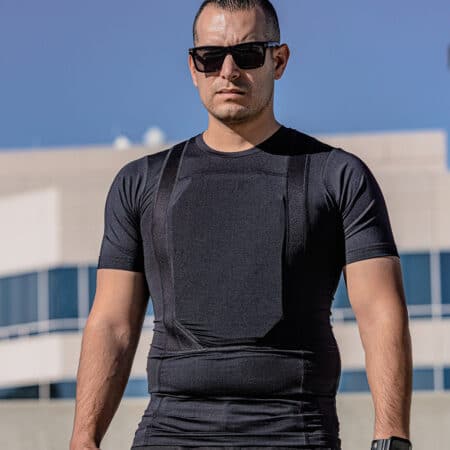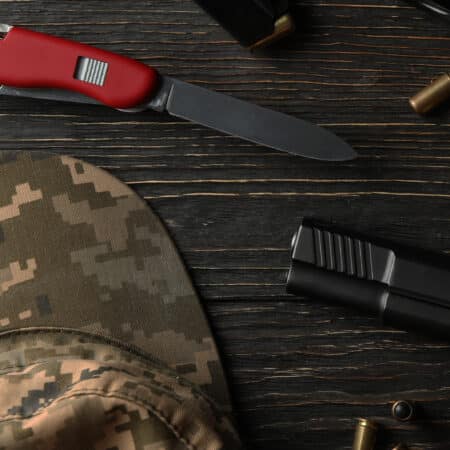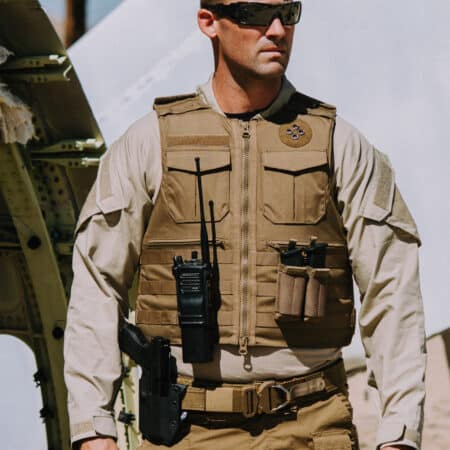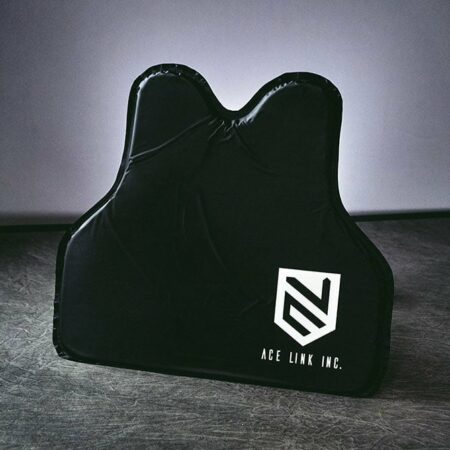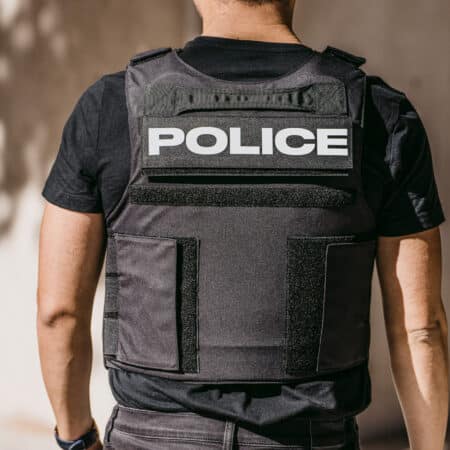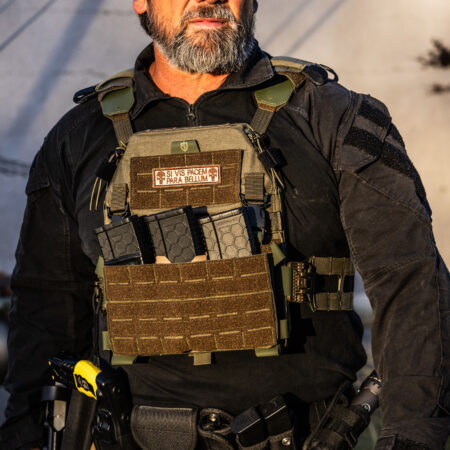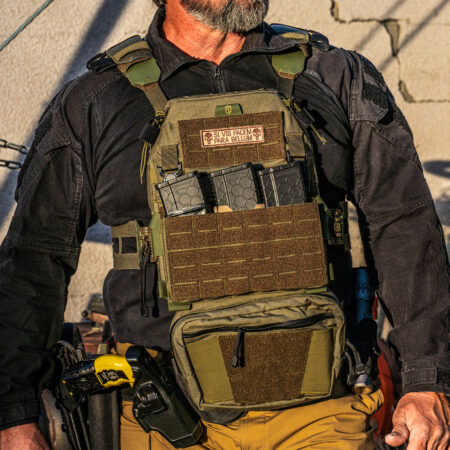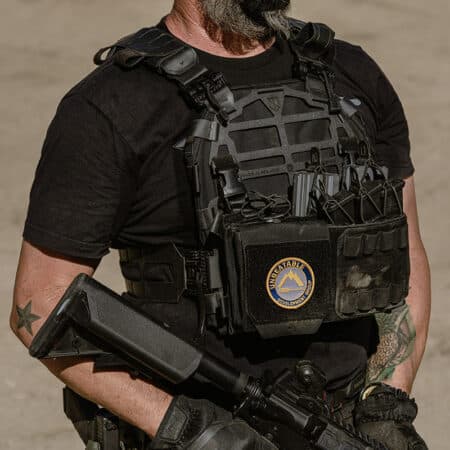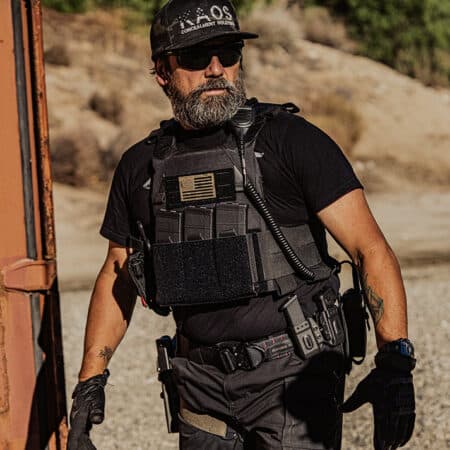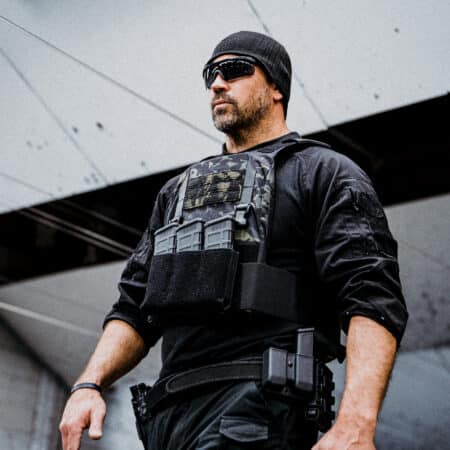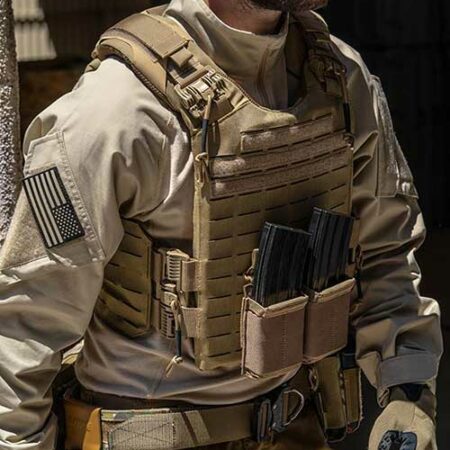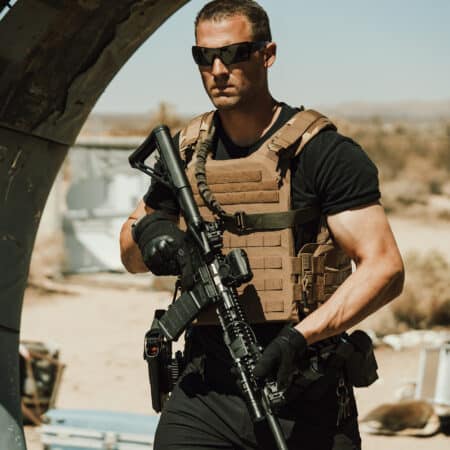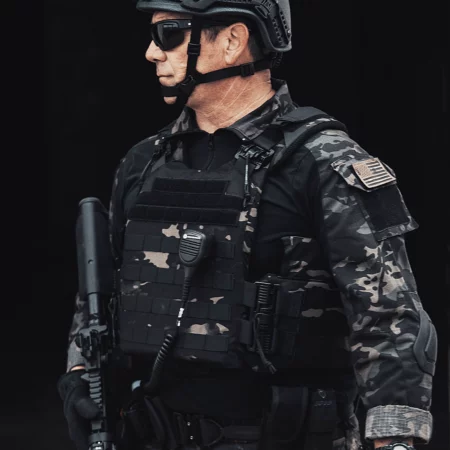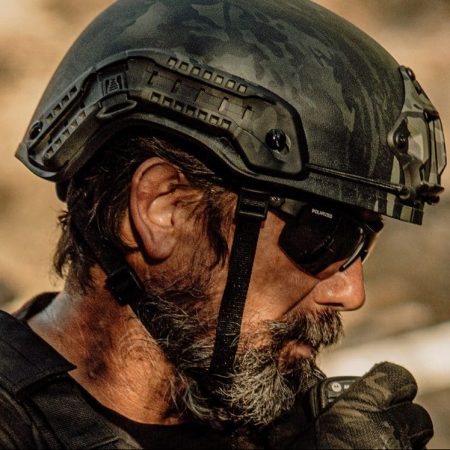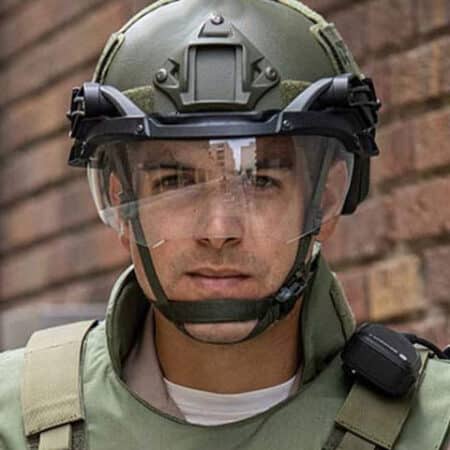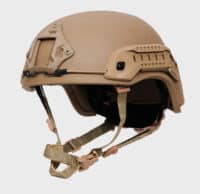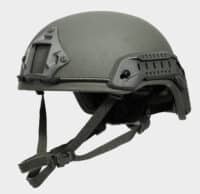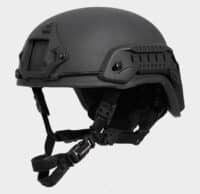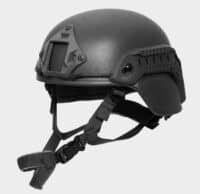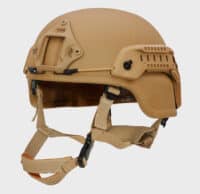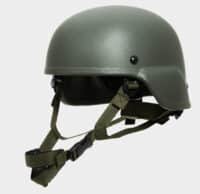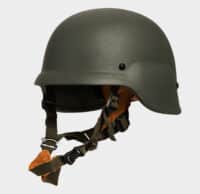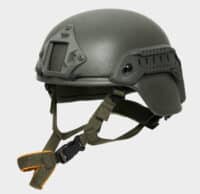
Ballistic Helmets
TACTICAL AND BULLETPROOF HELMETS

Level of protection
Price
Sort by
BALLISTIC HELMET GUIDE

What Makes a Helmet Bulletproof ?
A helmet is considered & “bulletproof” based on its ability to meet or exceed specific ballistic protection standards, such as those set by the National Institute of Justice (NIJ). However, it’s important to understand that no helmet is entirely bulletproof against all types of projectiles.
In fact, most “bulletproof helmets” on the market, usually only offer up to level IIIA ballistic protection. This means that they can stop most handgun rounds, but don’t offer protection against fast-moving and heavy rifle rounds.
Therefore, Marketing terms like “bulletproof” can sometimes be misleading. Ballistic Helmets is a much more suitable term, as it doesn’t imply that a helmet is completely bulletproof. Moreover, when you’re in the market for a ballistic helmet, you should look for helmets that are NIJ Tested.
An NIJ Testing can give you the confidence that the helmet you choose has been rigorously tested, according to the standards set by the NIJ, and will offer reliable protection as advertised.
NIJ Standards and Ballistic Helmet Protection: What You Need to Know
In the United States, the National Institute of Justice, or NIJ, is responsible for setting body armor testing and manufacturing standards. These standards are put in place to ensure that body armor offers consistent and reliable protection that people can trust.
According to the NIJ Standards, there are multiple levels of protection. Any body armor product, whether it is a vest or a helmet, needs to meet the testing requirements of a specific level to be certified for it.
For instance, if a helmet or vest meets the testing requirements of NIJ Level IIIA, it will be certified for that level. Our Ballistic Helmets are NIJ Certified and offer Level IIIA ballistic protection. This means that they can stop most handgun rounds, up to .44 Magnum, and .357 Sig.
The Importance of Multi-Hit Capability in Ballistic Helmets
In high-risk environments, you don’t have the time or resources to change your helmet immediately after it is shot. Therefore, the ability to withstand multiple impacts is crucial for any ballistic helmet. Multi-hit capability ensures the helmet can endure several ballistic threats or blunt force strikes without compromising protection.
To evaluate a helmet’s durability, check for NIJ certification or other rigorous testing standards. Our ballistic helmets are NIJ Level IIIA certified, which means that they are tested to stop 6 rounds of .44 magnum. However, our helmets are made to exceed certification levels and can take more shots, and fragmentation impacts.
Factors that affect multi-hit performance include the helmet’s material (e.g., advanced composite fibers like Aramid or UHMWPE) and its design for dispersing energy upon impact. By prioritizing multi-hit capability, users can ensure prolonged protection during prolonged engagements or hostile conditions, significantly improving their survivability and operational performance.
How Tactical Helmets Integrate with Other Protective Gear
Tactical helmets are designed to seamlessly integrate with a wide range of protective gear, ensuring comprehensive defense and tactical prowess in various operational environments.
You can use your ballistic helmet, along with your body armor for a complete armor system that shields all of your vital organs from head to torso. Helmets can also work with a wide range of specific gear like Ballistic Face Shield and Ballistic Visors, which can attach to helmets for eye and face protection from debris, shrapnel, or chemical agents.
To get the highest tactical advantage from your helmet, you can also mount gear like night vision, and communication systems on your helmet, which can greatly improve your situational awareness and combat abilities.
Your ballistic helmet isn’t just a form of head protection, but it is a multifunctional tool for modern tactical operations that integrates with a wide range of protective gear to make a highly effective tactical protection system.
How to Maintain and Care for Your Tactical Helmet
To maintain and care for your tactical helmet properly, follow these steps:
Cleaning:
Use Mild Soap and Water, Gently clean the exterior with a soft cloth or sponge, avoiding harsh chemicals that can degrade the material. Don’t submerge the helmet in water while cleaning, as it may compromise the integrity of padding and interior components.
Storage:
If you are storing your helmet for a long time, make sure to put it in a Cool, Dry Place: Store the helmet away from direct sunlight or extreme temperatures. You can also use a helmet bag to keep dust away from your helmet.
Inspection:
If you use the helmet regularly, make sure to inspect it from time to time, and check for cracks and damage. Inspect the helmet shell and suspension system for any visible signs of wear. Ensure that chin straps and interior padding are in good condition, with no fraying or loss of cushioning.
If the helmet has taken any significant hits, even if no damage is visible, consider replacing it to ensure optimal safety. Following these steps will help extend your helmet’s lifespan and maintain its protective capabilities.
Why a Bulletproof Helmet is Essential for Home Defense and Personal Protection
A bulletproof helmet can be an essential component of personal protection, especially in home defense or high-risk environments. While many focus on firearms and body armor, protecting the head is equally important, as it is vulnerable to ballistic, blunt force, and shrapnel threats.
Additionally, in a self-defense, or combat scenario, you want to have every advantage over the enemy that is possible, and having a high-quality tactical helmet gives you a lot of these advantages. You can mount a wide range of tactical gear like night vision, flashlights, and communication systems on your helmet, which can take your combat effectiveness to the next level.
In home defense situations where intruders may be armed, a ballistic helmet provides critical protection against stray rounds or direct confrontation. For civilians living in areas prone to violence or civil unrest, a helmet can offer peace of mind and a higher level of security in dangerous situations.
Top Tactical Helmet Models for 2024: Best Options for Combat and Defense
Best All Round Tactical ACH style Helmet – Ace Link Special Mission Gen 2 Ballistic Helmet
Best Helmet for Coverage and Protection – Ace Link PASGT Ballistic helmet
Best High-End Ballistic Helmet – Crye Precision AirFrame
Best Helmet for Comfort: Hard Head Veterans ATE Gen II Helmet
Ballistic Helmet Q&A
Here are the top 5 things you should look for when choosing a Ballistic helmet
Protection Level:
First and foremost, the most important feature of any ballistic helmet is protection. Choose a helmet that has been tested to NIJ Standard, and offers NIJ Level IIIA Ballistic protection. This is the most popular level of ballistic protection available in commercial bulletproof helmets. Additionally, the helmet should offer fragmentation and blunt force protection, essential for shielding against shrapnel and impact.
Comfort and Fit:
Look for a helmet that features an adjustable suspension system and memory foam padding with dedicated airflow channels to ensure a comfortable fit. Helmets with dial-lock retention systems allow for easy, one-handed adjustments, even with gloves.
Weight:
Look for a helmet that is lightweight. Our helmets are made from lightweight aramid fibers, and our best-selling Gen 2 Special Mission Ballistic helmet is 35% lighter than other ACH-style helmets while providing the same level of IA Ballistic protection.
Modularity and Accessories:
Look for helmets with integrated rails, NVG mounts, and Velcro panels for attaching gear like night vision goggles (NVGs), lights, and communications systems. This flexibility allows for mission-specific configurations without the need to carry separate headgear.
Durability and Environmental Resistance:
Choose a helmet designed to withstand harsh conditions like extreme temperatures, rain, and impact. Helmets with water-resistant outer shells and non-corrosive hardware are more suitable for long-term field use and exposure to tough environments.
Each of these features impacts performance, safety, and comfort, making them critical considerations when choosing the right helmet for tactical operations.
How to Properly Fit and Wear a Ballistic Helmet for Maximum Protection
If you want to get the best protection from your helmet and use it with confidence on the battlefield, you need to make sure that it fits you properly, and stays balanced on your head without moving about. Here are some tips to help you properly fit and wear a ballistic helmet.
Select the Right Size: Use a cloth measuring tape to measure the circumference of your head, just above your ears and eyebrows, and compare it to the size chart provided on the manufacturer’s website to find the size that is closest to your measurement. You can also add or remove padding layers inside the helmet to adjust its fit. Our ballistic helmets also come with a dial knob adjustment system on the back, which allows you to fine-tune its fit.
Position the Helmet Correctly: The helmet should sit level on your head, with the front edge about one inch above your eyebrows, ensuring full coverage of your forehead without hindering your vision.
Adjust the Straps: Tighten the chin strap snugly so the helmet doesn’t shift during movement. The side and rear straps should also be adjusted for balance and comfort.
Secure the Suspension System: Adjust the padding or suspension system (depending on the helmet type) to ensure a comfortable, snug fit. There should be no excessive gaps between your head and the helmet’s interior.
Check Stability: Shake your head gently; the helmet should not move or slide. If it does, readjust the straps and padding for a secure fit. Also, if you’re mounting any gear on the helmet, like NVG on the front, make sure to add counterweights to the back, so that the helmet does not shift forward because of the weight.
Consider Additional Padding: Some helmets offer extra padding for personalized comfort. Our Gen 2 Special Mission helmets come with an excellent padding system, which improves comfort, and enhances airflow to keep you cool as well.
Wear Compatible Gear: Ensure that other tactical gear, such as Night Vision or communication devices, integrates smoothly with the helmet without affecting its fit or balance.
What Types of Projectiles and Impacts Can They Stop?
The ability of a Ballistic helmet to stop projectiles and impacts depends upon its protection level.
As far as ballistic protection is concerned, most bulletproof helmets on the market offer Level IIIA ballistic protection. This means that these helmets can stop handgun rounds, but aren’t effective against larger and faster rifle calibers.
To meet the NIJ Level IIIA protection standards, the helmet needs to stop multiple hits from large pistol calibers like .44 Magnum and .357 Sig. They can easily stop smaller and more commonly used calibers like 9mm, .45 ACP, .40 S&W, and .357 magnum.
Moving on, let’s talk about fragmentation protection. This is one of the primary purposes of a ballistic helmet, as small fragments from explosives can be quite dangerous on the battlefield. Not all ballistic helmets on the market have any standardized testing system to determine the level of fragmentation protection their helmets provide, however, Our ballistic Helmets offer STANAG 2920 V50 AT 2150 Ft/Sec fragmentation protection.
STANAG 2920 is a NATO standard used to measure the fragmentation protection of ballistic materials. The “V50 at 2150 ft/sec” means that the helmet can stop 50% of fragments traveling at a velocity of 2150 feet per second. This rating ensures that the helmet offers substantial protection against high-velocity shrapnel and debris encountered in combat situations, providing critical defense for the wearer in environments with explosive hazards. The V50 test is a widely accepted benchmark for evaluating the effectiveness of armor against fragmentation.
Lastly, let’s talk about blunt force impacts. Ballistic helmets need to protect you from blunt force attacks as well. Therefore, we make our ballistic helmets to be extremely durable. Moreover, we make sure that our helmets pass the AR/PD 10-02 Blunt Impact Resistance test. Which is the same impact resistance test that the US Army uses for their ACH helmets and the DOT uses to certify motorcycle helmets.
Essential Tactical Helmet Accessories for Enhanced Performance
When it comes to ballistic helmets, enhancing performance goes beyond basic protection. Various tactical accessories can transform your helmet into a versatile tool for communication, visibility, and protection. From advanced communication systems to night vision mounts, these attachments not only improve functionality but also provide greater comfort and situational awareness. So, here are some essential helmet accessories that can significantly boost your operational efficiency.
Communication Systems: Integrated or mountable headsets provide clear communication in noisy environments, ensuring seamless coordination during operations. If you are a civilian, you can also get ear protection that can be mounted on your helmet.
Night Vision: Most tactical helmets come with NVG mounts, which allow you to mount night vision on your helmet. Enhancing visibility and situational awareness in low-light or night conditions.
Visors and Face Shields: Ballistic visors and face shields are essential accessories for law enforcement officers working in anti-riot units. These visors and face shields can provide enhanced protection against debris, shrapnel, or chemical threats.
Mission-Specific Attachments: Various other accessories can be mounted on tactical helmets depending on your mission requirements. These accessories can include flashlights, or in some situations, IR Strobes. IR strobes are mounted on helmets to make it easier for airborne assets like drones and close air support to identify friendly targets than they are using their Infrared targeting systems.
Counterweights: counterweights can help balance the weight of front-mounted gear like night vision devices, reducing neck strain, and improving overall fit and mobility.
Ballistic Helmet Materials: Aramid vs. Polyethylene vs. Steel
How to Choose a Ballistic Helmet for Police, Military, or Civilian Use
How to Choose a Ballistic Helmet for Police, Military, or Civilian Use
Ballistic helmets serve crucial roles across law enforcement, military, and civilian applications, providing essential protection in various high-risk scenarios. Police officers use them for riot control and tactical operations, where modularity and communication integration are key. Military personnel need durable, tactical helmets with the highest ballistic and blunt force protection for combat zones. Civilians may seek lightweight options for personal safety, whereas some only want helmets for recreational or aesthetic purposes. Understanding these different roles ensures that the right helmet is chosen for the specific demands of each group.
Law Enforcement:
Police officers often require lightweight ballistic helmets that are versatile and modular. They need helmets compatible with accessories like visors for riot control, integrated communication systems for tactical coordination, and night vision mounts for low-light operations. Level IIIA protection, which guards against handgun rounds and fragmentation, is typically sufficient for law enforcement scenarios, while features like adjustable padding ensure comfort during long shifts.
Military:
Military personnel require Helmets that offer high levels of protection against ballistic impacts, fragmentation, and blunt force. Additionally, in active military roles, soldiers need tactical helmets that allow the integration of modern gear like Night Vision, and high-end communication systems.
Civilian:
For civilians, particularly those involved in private security or recreational activities like shooting sports, the focus should be on balancing protection, comfort, and budget. A helmet rated for NIJ IIIA protection, which guards against common handgun threats, is often sufficient. Civilians may not require as many modular features but should look for helmets that offer adjustable fitting systems for personalized comfort.
Some civilians may also choose bump helmets which don’t offer any ballistic protection and are more suited for recreational activities like airsoft, and sports shooting.
Learn More About Tactical Helmets
What type of material is a tactical helmet made out of?
Tactical helmets, commonly referred to as bulletproof helmets, primarily utilize Aramid fiber, a substance renowned for its strength and bullet-stopping capability. When engineered properly, this material creates a lightweight solution and offers robust protection against handgun ammunition.
Key features of the materials used in a tactical helmet include:
- Aramid Fiber Composition: Aramid fibers, when spun together, result in an extremely strong thread. By weaving these threads, manufacturers produce a lightweight yet formidable material tailored for bullet resistance.
- Shell Design & Purpose: The shell’s primary function is to deform upon bullet impact, absorbing and dispersing the energy. This design ensures the shell remains intact without fragmenting, thereby preventing potential brain injuries.
- Internal Liner: This reinforcement layer enhances the helmet’s structural integrity, allowing it to bear severe impacts without shattering. Like the outer shell, the liner is designed to deform upon impact but remains unfragmented, offering an additional layer of protection.
Can ballistic helmet stop a bullet?
Yes, a ballistic helmet can stop a bullet.
Ballistic helmets are specially engineered to provide protection against a variety of bullets, depending on their rating and construction. The shell of the helmet undergoes rigorous testing and is rated based on established standards, such as the National Institute of Justice (NIJ) standards. For instance:
- NIJ Level IIIA: This rating typically ensures protection against handgun rounds, including bullets from weapons like the 9mm and .44 Magnum.
- NIJ Level III: Helmets with this rating are designed to withstand even higher velocities and are capable of stopping rifle rounds, including the 7.62x51mm round.
It’s essential to note that the actual performance of a ballistic helmet can vary based on factors such as the angle of impact, the distance from which the bullet is fired, and the specific design and materials of the helmet.
For a comprehensive understanding of a helmet’s capabilities, check our blog article on what should a ballistic helmet protect from.
What is the best ballistic helmet?
Selecting the optimal ballistic helmet requires a keen understanding of its intended use, features, and the balance between protection and comfort. Here are some key considerations to keep in mind:
- Accessory Compatibility: Ensure that the helmet can be easily accessorized, especially with vital equipment like night vision goggles. Some helmets are designed with an integrated rail system, allowing users to attach a variety of tools, lights, or equipment.
- Fit and Comfort: The fit of the helmet is paramount. A helmet that is too tight can lead to discomfort and headaches, while a loose-fitting helmet might compromise protection. Always prioritize a snug and comfortable fit.
- Budget Considerations: High-quality materials and enhanced protective features can increase the cost of a helmet. It’s crucial to find a balance between quality and affordability, always considering available sales or discounts.
There are several recommended types of ballistic helmets, each with unique features and benefits:
- High Cut Ballistic Helmet: Provides a lighter-weight design with more exposure, allowing for better compatibility with communication devices and headphones. This model has been designed with military and law enforcement in mind.
- MICH Bulletproof Helmet (Modular Integrated Communications Helmet): Replaced the ACH Helmets and it favored by the military, this helmet offers superior protection from ballistic threats and boasts improved comfort due to the inclusion of comfort pads. Its modular design allows for increased versatility and adaptability in various combat situations.
- PASGT Helmet (Personnel Armor System for Ground Troops): A traditional design used by many military forces, offering reliable protection with a more encompassing fit.
- MICH Combat Helmets – Level IIIA helmet with full cut design for ear protection. Additionally comes with side rails and NVG mounts (same as other helmets)
Whichever helmet you opt for, its purpose and specifications should align with your requirements. Remember to thoroughly research and understand each type’s features and benefits before finalizing your purchase. Our blog article will help you to answer your questions about ballistic helmet types and configurations.
Can civilians own ballistic helmets?
Yes, in most jurisdictions within the United States, civilians can legally purchase and wear ballistic helmets and tactical helmets. However, there are essential points to consider:
Key Points to Understand:
- State Regulations: Each state has its distinct body armor laws, commonly referred to as “body armor laws.” These regulations dictate who can purchase, own, and wear ballistic protection equipment like helmets.
- Convicted Felons: In general, across most states, it’s prohibited for convicted felons to own or wear body armor, including ballistic helmets.
- Occupation Irrelevant: Contrary to popular belief, body armor laws typically do not distinguish between civilians, law enforcement officers (LEOs), security personnel, or any other occupations. The right to own and wear body armor is typically a matter of legal status, not professional status. Many military and law enforcement officers wear ballistic helmets and tactical helmets as a part of their duty.
- Licensing Myths: Some assume that only individuals with a License to Carry (LTC) or law enforcement officials can legally own ballistic helmets. This is a misconception. While certain licenses might enable possession of other types of protective or defensive gear, they’re usually not a prerequisite for owning ballistic helmets.
- Local Sheriff Consultation: It’s always a prudent step to consult with your local county Sheriff’s office for specific and up-to-date information on body armor laws in your area. They can provide clarity on any local regulations or restrictions you might need to be aware of.
In conclusion, while it’s generally legal for civilians to own ballistic helmets, understanding the nuances of local and state laws is critical. Always make an informed decision by checking with local authorities or legal experts. Please refer also to our blog article where we explain in details all important questions about who wears ballistic helmet or tactical helmet.
Do ballistic helmets expire?
Ballistic helmets, much like other personal protective equipment, have a lifespan determined by a multitude of factors. The durability and protective capability of a helmet can degrade over time due to various reasons.
Ace Link Armor Helmet Specifications:
- Warranty: Ace Link Armor helmets come with a 5-year manufacturer’s warranty. During this period, the ballistic protection of the helmet is guaranteed.
Factors Affecting Helmet Service Life:
- Ballistic Material: The type and grade of the material used in the helmet’s construction play a crucial role in determining its lifespan.
- Material Condition: Scratches, cracks, or any signs of aging in the ballistic material, especially if the helmet has been stored for extended periods, can compromise its integrity.
- Environmental Exposure: Prolonged exposure to varying weather conditions, such as extreme temperatures or humidity, can accelerate the wear and tear process.
- Physical Misuse: Accidental drops, impacts, or other forms of misuse can adversely affect the helmet’s protective capabilities.
Best Practices:
- Proper Care: Ensure that your helmet is stored as per the manufacturer’s guidelines. A well-maintained helmet can significantly prolong its effective service life.
- Regular Inspection: Before using your tactical helmet, always inspect it for visible damage or signs of wear. Check the exterior for cracks or dents, and ensure the inner pads remain firmly attached to the shell.
- Quality Matters: Investing in top-notch gear is crucial. Once procured, familiarize yourself with its proper usage and regularly check its condition to ensure it functions as intended.
In conclusion, while tactical helmets are designed to offer robust protection, their efficiency is influenced by various factors. Always remain vigilant about the condition of your protective gear, and when in doubt, consult with experts or the manufacturer.
Does dropping a ballistic helmet ruin it?
Ballistic helmets, crafted for rigorous combat scenarios, are designed with resilience in mind as the military helmets should be. The question of a helmet’s integrity after a drop has been a topic of debate. Here’s a comprehensive analysis from a military expert’s standpoint:
Aramid Fibers and Drops: There’s a common misconception that dropping a helmet might damage its aramid fibers, diminishing its ballistic performance. While aramid fibers are sensitive, they are integrated into helmets to withstand substantial force. A drop, especially from waist height (common in scenarios like urban operations), is unlikely to jeopardize the fibers’ protective capabilities.
Key Considerations:
- Nature of Impact: Bulletproof helmets are designed to endure powerful impacts, much more forceful than a mere drop. However, the nature and angle of the impact, combined with the surface it hits, can vary the potential damage.
- Lack of Empirical Evidence: While this topic remains widely discussed, there hasn’t been any conclusive testing to verify the impact of drops on helmets’ ballistic performance.
- Height Matters: While a waist-height drop might not severely compromise the helmet, falls from significantly greater heights could. The higher the drop, the greater the potential for damage.
Best Practices:
- Regular Inspection: Post any impact, minor or major, and always inspect your tactical helmet. Look for visible cracks, dents, or any deformation.
- Avoid Forceful Drops on Rough Surfaces: Dropping a helmet with substantial force on rough or hard terrains could induce what’s known as ‘back face deformation’. This deformation could potentially weaken the helmet’s structure and damage its internal components.
In summation, while ballistic helmets are robustly designed for protection, they aren’t invincible. Tactical helmets care and regular inspections are paramount to ensure their longevity and effectiveness.
Is it worth getting a ballistic helmet?
The decision to acquire a ballistic helmet depends on multiple factors, including the intended use, the level of threat one might encounter, and the budget considerations. If you’re pondering over the worthiness of a ballistic helmet, here’s a comprehensive analysis from a military expert perspective:
- Intended Use:
- Military & Law Enforcement: For personnel routinely exposed to combat scenarios, ballistic helmets are essential. They provide protection from ballistic threats, shrapnel, and other airborne hazards.
- Civilian Usage: Civilians might consider a ballistic helmet for specific scenarios such as personal protection during civil unrest, security jobs, or even recreational shooting.
- Protection Levels:
- Varied Threat Levels: Ballistic helmets, especially Level IIIA helmets, are designed to protect against handgun rounds and fragmentation. If you expect to encounter such threats, a ballistic helmet is invaluable.
- Added Accessories: Many modern helmets come with rails for accessories, NVG mounts, and other modular features. If there’s a need to integrate communications, night vision, or other tools, a tactical helmet becomes worthwhile.
Is there a level 4 ballistic helmet?
Understanding the specifications and classifications set by the National Institute of Justice (NIJ), the primary U.S. body for establishing standards in body armor, is crucial when assessing the effectiveness of ballistic protection. Here’s a detailed breakdown:
NIJ Ballistic Levels for Helmets:
- Level IIIA Helmet: This is the peak standard for ballistic helmets. Helmets rated at this level, often referred to as “IIIA helmets,” are tested rigorously to halt projectiles from firearms such as 9mm handguns and .44 Magnum revolvers. For many professionals, the IIIA helmet offers the ultimate protection within the current scope of helmet technology.
- Level IV (4): The NIJ does have a Level IV categorization, but this applies strictly to hard armor plates. These plates are tailored to stop armor-piercing bullets and are distinctively used in plate carriers, not helmets.
- No Level IV Helmet: At present, no helmet, including the IIIA helmet, meets the Level IV standard, meaning no helmet is ratified to obstruct armor-piercing rounds in the way a Level IV plate can.
Evolving Defense Solutions:
- Future Shell Technology: The defense sector is persistently advancing, and with the introduction of future assault shell technology, we might soon witness even more robust helmet designs.
- Always Validate Protection Claims: While continuous innovation aims to achieve the ultimate protection, it remains essential to ensure any protective equipment aligns with recognized standards.
In sum, even with innovations on the horizon like future assault shell technology, the highest current level of bulletproof helmet is the IIIA helmet. Make informed decisions and remain critical when assessing protection equipment’s promises.
 go back
go back
YOUR SHOPPING CART
your cart is empty
